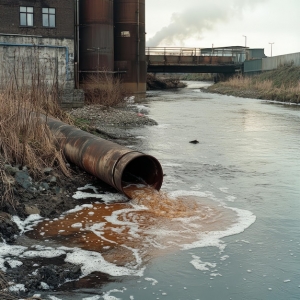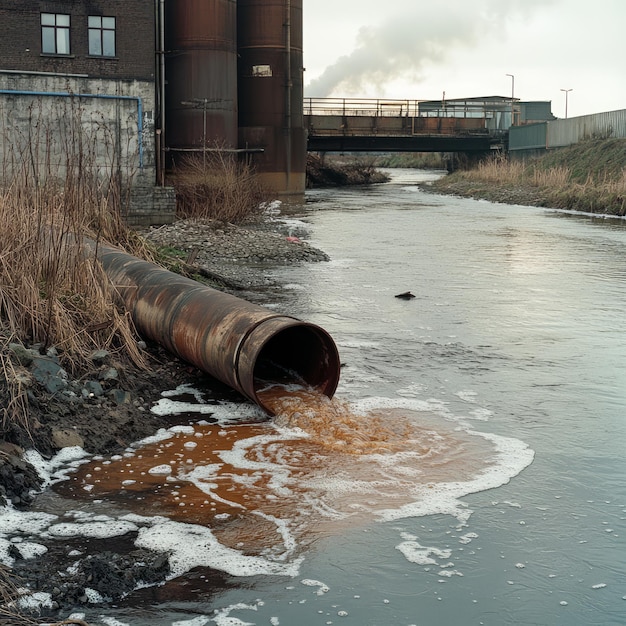

India ranks 120th out of 122 countries on the Global Water Quality Index. According to the World Economic Forum, an advocacy and non-governmental think tank based in Switzerland, water pollution is mortally affecting millions of Indians. Untreated sewage is the largest source of water pollution in India, with nearly 40 million litres entering rivers and other water bodies each day. The discharge of industrial effluents, including heavy metals and chemicals, into the ocean threatens marine life and water quality. India is also one of the largest producers of plastic waste, generating an estimated 26,000 tonnes daily. India is a hub of oil and gas exploration and transportation, increasing the risk of producing oil spills. Agricultural runoff is another source of water pollution.
A World Bank report suggests that water pollution can reduce the GDP growth in downstream areas by up to a third. One study suggests that being downstream of polluted stretches is associated with a 9% reduction in agricultural revenues. Plus, it harms aquatic and terrestrial ecosystems. Water pollution can also increase the risk of disease in people who rely on the river water for their drinking water supply and increase mortality and breathing ailments in adults—all adverse effects of water pollution.
Some private efforts to address water pollution in India include the Ocean Clean Up and Bharat Clean Rivers Foundation Agreement. Together, these organisations are working to identify sources of waste and pinpoint locations for intervention in Mumbai's rivers and to help develop suitable new plants to fight plastic pollution in the Mumbai Metropolitan Region. The two organisations signed a Project Facilitation Agreement on January 25, 2024. The mission of Ocean Clean Up is to clean up plastic pollution already floating on the high seas while stopping the influx of waste leaking into the oceans from rivers. This is only the first step because the problem needs to be tackled on a war footing.
The National River Conservation Plan (NRCP) has also helped improve water quality in India to some extent. The Government's Central Pollution Control Board, Ministry of Environment and Forests established a National Water Quality Monitoring Network, which now comprises 4,484 stations in 28 states and 7 Union Territories. The network covers 719 rivers, 348 lakes, 134 tanks, 107 ponds, 102 creeks, seawater, 36 canals and 81 drains, 11 water treatment plants and 1,235 wells. They are monitored on a half-yearly, monthly, or quarterly basis.
In the case of groundwater, the Central Water Commission is monitoring water quality at 309 key locations covering all the major river basins in India. This has helped collect data, but it is not enough. Despite the government modernising its data-collecting system, time-dense data are made available on the internet in real-time to set up effective interventions to clean rivers. Though satellite imagery has improved data collection, much must be done to make it more comprehensive.
According to a World Economic Forum study, about 70% of surface water in India is unfit for consumption. The cost of environmental degradation in India is estimated to be INR 7.5 trillion a year. The adverse health effects relating to water pollution are also estimated at INR 470 to 610 billion a year. Most are associated with diarrhoea-related morbidity among children under 5 and other population morbidities.
There is still a large gap between the generation and treatment of domestic wastewater in India. The problem is not only that India lacks sufficient treatment capacity but also that the existing sewage treatment plants do not operate well and are not maintained. Most government-owned sewage plants remain non-operational due to improper design or poor maintenance, a lack of reliable electricity supply to operate the plants, absent employees, and poor management. The wastewater leaks into the surface or ground water or evaporates. Uncollected waste accumulates in the urban areas, causing unhygienic conditions and releasing pollutants.
Further, pesticides that have been banned worldwide and some by the Indian Government due to their environmental damage are still commonly used as cheap and easily available alternatives to other pesticides in India. These chemicals are part of Persistent Organic Pollutants (POPs), which are potential carcinogens and mutagens. The levels of POPs found in several Indian rivers are well above the permissible limit.
The next big cause of river pollution is the wastewater from many industries discarded into rivers. As told to Parliament by Ashwini Kumar Choubey, MOS for the Union Ministry of Environment, Forests and Climate Change, on February 5, 402 million litres per day of industrial effluents by 3,186 grossly polluting industries were discharged into the Ganga and Yamuna rivers. 349.31 MLD is discharged into the Ganga and 153.36 into the Yamuna. These discharged effluents contain heavy metals such as lead, cadmium, copper, chromium, zinc, and arsenic, negatively affecting aquatic life and humans. It can lead to impaired cognitive function, gastrointestinal damage or renal damage.
According to the Central Pollution Control Board of India, around Rs 200 billion was spent cleaning the Ganga between 1986 and 2014. Since 2014, another INR 250 billion has been allocated. As of date, 200 sewage infrastructure projects, including 1 decentralised module project, have been sanctioned at a total cost of Rs 31,810 crores, of which 116 projects have been completed. The Ganga is polluted with human waste and industrial contaminants. Under the Government's Namani Gange Flagship scheme, the former Minister of State for Jal Shakti, Bishweswar Tudu, in a written reply in the Lok Sabha on February 8 this year, said that until December 31, 2023, 457 projects had been taken up under the Namani Gange programme at the cost of Rs 38,438.05 crores. Of these, only 280 have been completed and operationalised. But the Ganga still remains among the most polluted rivers in the world.
Similarly, the Yamuna, a tributary of the Ganga, is among the most polluted rivers in India. The river is polluted by both point and non-point sources, with the National Capital Territory Delhi being the major contributor, followed by Agra and Mathura. Approximately 85% of the total pollution is from domestic sources. The catchment of the Yamuna river system covers parts of the states of Uttaranchal, Uttar Pradesh, Himachal Pradesh, Haryana, and Rajasthan, which all suffer from water pollution.
The seven-point action plan to rejuvenate the Yamuna includes upgrading the 18 existing sewage treatment plans (STPs), building three new plants, and building 40 new decentralised STPs. So why is the Yamuna not getting cleaned? Reduced water flow is the key factor behind the river's continuing degradation and the failure of the cleaning projects.
One solution to the Yamuna River pollution problem is to train and educate people on how to properly maintain the sewage system and waste disposal methods and to develop a waste management system that will enable the community to earn a living by recycling and upcycling waste. At the same time, rainwater harvesting should be undertaken to meet the uncontaminated water needs for domestic and other purposes.
The Ganga rejuvenation efforts by the Union Government and the Yamuna Clean Up programme leave much to be desired. Industrial wastewater treatment is highly unregulated. The government has taken some initiatives to prevent industrial pollution of water resources. Zero Liquid Discharge (ZLD) is a water treatment process to eliminate liquid waste from industries that release polluted wastewater, such as the fertiliser sector and distilleries. ZLD has been encouraged by the government and has since been implemented at some large industrial plants like Unilever and P&G. However, installation costs and failure to process large amounts of dissolved solids in wastewater are huge deterrents for industrial plants to adopt this technology.
The faecal coliform levels in the rivers Yamuna, Ganga, Gomti, Ghaghara, Chambal, Mahi, Vardha, and Godavari are worrying. We are slow to catch up with the pace of progress in this field when it comes to treating domestic sewage and subsequent utilisation of treated sewage for irrigation. This treatment can prevent pollution of water bodies and reduce the demand for fresh water in the irrigation sector.
A recent project in 3 northern states shows that roughly 10-25% of all the plastic waste generated from different city hot spots was littered and not routed into recycling and appropriate waste disposal channels. The litter generated or accumulated in different city hot spots is a major source of plastic leaking into the riverine system, especially in the rainy season. Much of the litter is multilayer plastic packaging, disposable bottles, cutlery, nylon sacks and polythene bags, especially in Haridwar, Agra and Prayagraj.
Macroplastics include items such as ghost fishing gear, abandoned, lost, and discarded nets, and other plastic equipment used by the fishing industry. Such macroplastic pieces, which are clearly visible to the naked eye, kill millions of aquatic animals every year. Then there are microplastics, or tiny pieces of plastic particles that have infiltrated the entire marine food web and ended up in humans.
Polluted rivers in India end up entering the ocean. India is a significant source of plastic emissions, and a study shows that billions of plastic materials are dumped into the Indian Ocean each year. Currently, India is reeling under a marine debris crisis. Some 15,343 tonnes of waste are dumped in the South Asian seas daily, and they are generated from 60 major Indian cities, according to the United Nations Environmental Programme (UNEP). The Indian Ocean currently faces many challenges, such as overfishing, climate change, deep sea mining, seismic blasts, plastic pollution, coral reef degradation, and coastal development.
A World Bank report highlights the plight the country is facing. About 163 million Indians lack access to safe drinking water, 210 million Indians lack access to improved water sanitation, and 26% of communicable diseases are linked to unsafe water. In addition, India is ranked 13th on Aqueducts's list of extremely water-stressed countries. Northern India faces severe groundwater depletion. The primary source of water in India is rain. Rain helps water bodies to maintain their levels. Changing patterns of monsoons and rainfall do not augur well for the water supply in our country.
On the World Quality Index, India draws nearly 25% of the world's groundwater—that's more than the U.S. and China combined. India's depleting groundwater reserves impair our drinking water supply, and about 600 million people are facing extreme water stress. In the face of all these facts and figures, India cannot remain complacent. Real progress will only come when we have tackled all these problems at home instead of strutting and winning brownie points on the world stage.